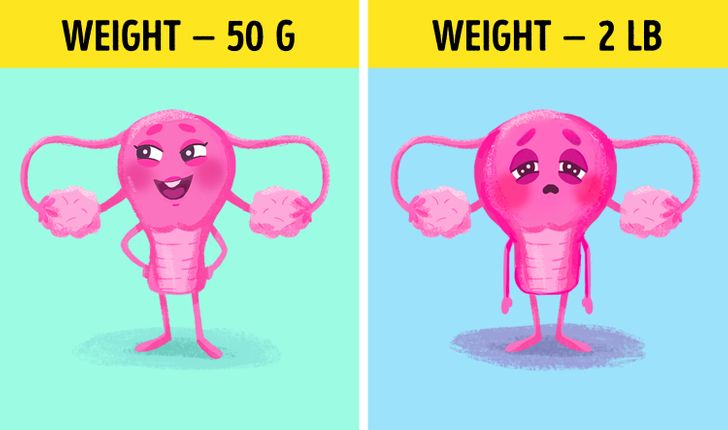Despite being one of the most exciting moments in life, giving birth to a boy puts pressure on the female body. Although it takes some young mothers only 2-3 days or even 24 hours to get out of the hospital if they are uncomplicated, the rehabilitation process actually takes much longer.
We decided to find out what changes the female body goes through during childbirth and how long it really takes to recover.
Belly

Subcutaneous fat in the abdomen that protects the baby from external factors can increase significantly during pregnancy. Hormonal changes and irrational nutrition facilitate the process. That is why the condition of a woman’s belly during the postpartum period depends on how many extra pounds she gained during pregnancy.
Postpartum abdominal muscles are reduced only after 6-8 weeks, while they take longer to recover after cesarean section. If there are no problems with diastasis recti (also known as abdominal separation) that require medical help, the mother can begin to exercise between 1.5 and 2 months after delivery.
If a woman does not exercise too much, it will take 1 to 2 years for her abdominal muscles to recover.
Breasts

During lactation, the female breasts increase in size due to the enlargement of the segments elongated by the milk. Ligaments and muscles cannot support breast tissue in the same way that they supported it before pregnancy, as their weight in the postpartum period increases 2-3 times.
This can cause ptosis or sagging breasts. Also, the nipples and areolas enlarge and darken as the color can turn transparent and blue and the blood vessels can become visible as the skin thins.
The more milk a woman has, the heavier her breasts become, and to cope with the increased load, the breasts need proper support and care.
The younger the mother, the more elastic her tissues are. Also, the more the breast muscles are trained before pregnancy, the less time it takes for them to recover after the breastfeeding period.
Unfortunately, it is not always possible to return to the early “maiden” forms, but if a woman exercises her muscles, she can get good results.
Proper nutrition, the consumption of vitamins of groups A, B and C, a light hand massage on the breasts, comfortable supportive underwear and, of course, the exercises, can help to preserve the beauty of the breasts and the elasticity of the skin.
Musculoskeletal System

During pregnancy, a woman’s musculoskeletal system undergoes an increased load and the body produces the hormone relaxin, which is responsible for the elasticity of the vertebral muscles and ligaments.
This load causes changes in the spine, lower extremity joints, pelvic bones, and back muscles. During this period, the center of gravity changes, causing the spine to dislocate, which can lead to pain and discomfort.
After delivery, there is a drastic decrease in the levels of progesterone and estrogen, which slows down the body’s metabolism and leads to an increase in adipose tissue.
The recovery period of the musculoskeletal system after childbirth occurs gradually and takes 3 to 4 months. During this time, a woman may experience joint and bone pain and may experience muscle cramps.
Wearing a postpartum support bandage, as well as doing special exercises to strengthen your back muscles, can help control low back pain. The aforementioned changes can completely disappear only if the woman does not have problems with her musculoskeletal system initially.
But sadly, many women today suffer from abnormalities like scoliosis and flat feet from a young age.
Uterus

The uterus undergoes many changes during pregnancy and during the birthing process. The weight of the uterus of a woman who has never given birth is normally 40 to 60 g, while a woman who has given birth has a uterus that weighs approximately 80 g.
At the same time, the weight of the uterus immediately after delivery is 0.8 kg. These changes are the result of muscle hypertrophy that occurs during pregnancy.
The lower part of the uterus is at the level of the navel, so a new mother looks like she is still pregnant for the first few days after giving birth.
After the placenta detaches, the uterus looks like a superficial wound and heals on its own on the ninth or tenth day. During the first 3-7 days, there is usually heavy uterine bleeding that gradually subsides.
After that, in the next 6 to 8 weeks after giving birth, there are problems with blood called lochia. If the uterus contracts normally, its weight will decrease 2 times after 10 days.
About 1.5 to 2 months after delivery, the uterus will eventually recover and return to its normal weight, which is 50g to 80g.
Psychological And Emotional Load

During the postpartum period, young mothers often suffer from irrational anxiety attacks, fatigue, and drastic mood swings.
A woman experiences a huge psychological burden, is constantly concerned about the health and development of her child, does not get enough sleep, and constant fatigue can cause her psychomotor reactions to decrease.
Some women suffer from postpartum depression. The reasons for this depressive condition can be the guilt of the young mother for the lack of time, as well as the subconscious conviction that the baby is the reason for the temporary insolvency of the woman.
This situation requires the help of specialists or at least a consultation with a psychotherapist who will help the mother to overcome her problems and begin to enjoy her motherhood.
Generally speaking, a new mother needs the help, support, and understanding of her close friends and family, regular walks outside, and a complete and balanced nutrition plan.
You have a son? What problems did you encounter during the postpartum period and how did you overcome them? Share your thoughts with us in the comment section below!


